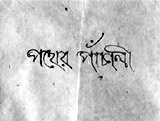
|
Pather Panchali (1955, India) (aka
Song of the Road, or Lament of the Path)
In Indian director Satyajit Ray's first film, the low-budget,
visually-poetic, coming-of-age drama (the greatest Indian film of
all-time) - the first of an "Apu Trilogy" followed by Aparajito
(1956) (aka The Unvanquished) and Apur Sansar (1959) (aka
The World of Apu) - with its realistic portrayal of low-class
poverty in India - backed by sitar ragas of famed Ravi Shankar:
- the point of view of the protagonist Apu (Subir
Banerjee) - the youngest child of a small Brahmin family in an
impoverished, rural Bengal village, led by Harihar
"Hari" Ray (Kanu Bannerjee), a well-intentioned dreamer
(playwright and poet) and part-time priest, but not always a good
provider for his overworked, self-sacrificing, harried wife Sarbojaya
Ray (Karuna Bannerjee)
- the character of elderly, stooped-backed, toothless,
wrinkled crone-aunt Indir Thakrun (Chunibala Devi) (Hari's elderly
cousin), who did nothing to discourage Apu's older sister Durga (Uma
Das Gupta) from stealing fruit from the neighbor's mango grove once
owned by her family
- the progression of simple daily life and survival,
including meal preparation, the children chasing after the candy
vendor, teasing, or playing
- Durga's and Apu's favorite past-time - awaiting the
thundering roar and whistling of an approaching train - and watching
the big steam engines pass by (a symbol of promise and the future)
from an adjacent meadow of tall grass and rice fields, and in one
instance on their return, their discovery of their Auntie's starved-to-death,
slumped-over body
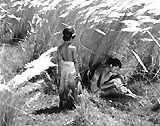
|
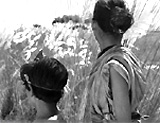
|
|
Tall Meadow of Grass and Rice Fields - Passing
Train
|
- the scenes of torrential and deadly monsoon rains
and whistling winds that decimated the landscape, and brought a
lethal chill of pneumonia to young Durga; as she was very ill and
tended by her mother, the winds shook the door of their hut - with
the accompanying image of Ganesh (the beloved, good-luck Hindu
deity with an elephant's head) illuminated by the flickering flame
of an oil lamp; when Durga perished from fever and respiratory
exposure in the arms of her mother, the flame went out - and the
statue of Ganesh was only visible during lightning flashes
- the sequence of Harihar Ray's long-overdue return
home after being away for five months to seek work - bringing gifts
of a wooden board and rolling pin, and a picture of goddess Lakshmi
for his wife ("Our worries are over. I'm back" - he reassured
her) - and the eloquent wordless, grieving moment when Harihar realized
that his daughter Durga had died in his absence (he had brought her
a new sari) - his sobbing wife sank to the ground clutching the sari
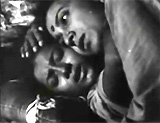
|
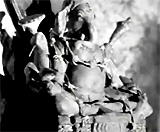
|
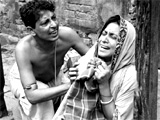
|
|
Durga's Illness and Death
|
Statue of Elephant-Headed Ganesh - Seen in Flashes
of Lightning
|
Wife's Grieving Reaction to the Death of Durga
Once Hari Returned
|
- in the film's conclusion, the family's bittersweet
departure and move (sitting on the back of a bullock-cart) from
their ancestral home to the city of Benares to find better living
conditions
|
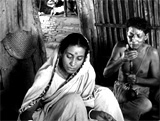
Brahmin Family's Wife

Apu (Subir Banerjee)

Aunt Indir Thakrun with Apu's sister Durga
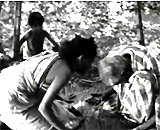
Slumped Over Aunt Discovered Dead
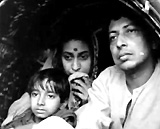
Family's Departure on Ox-Cart
|






